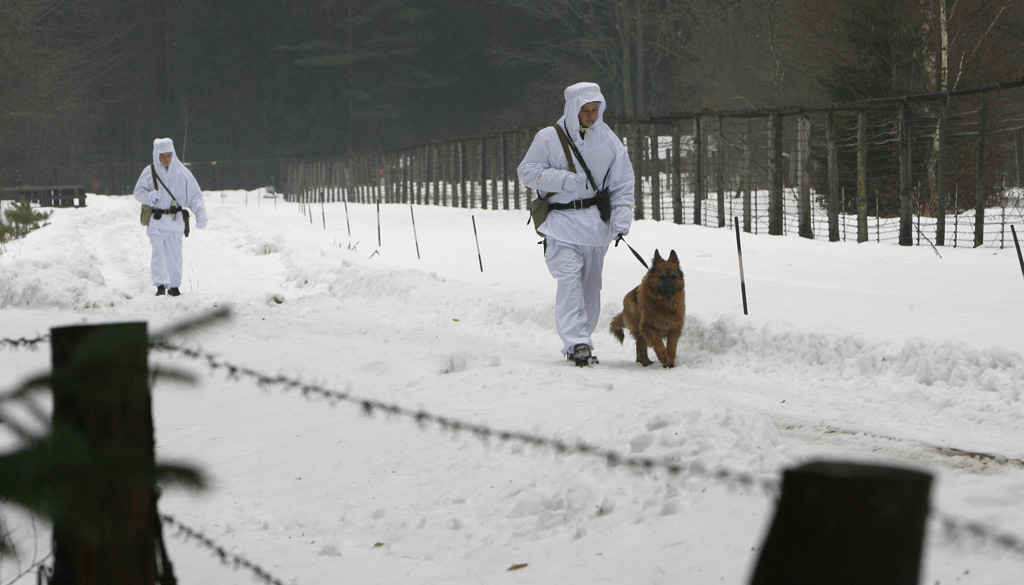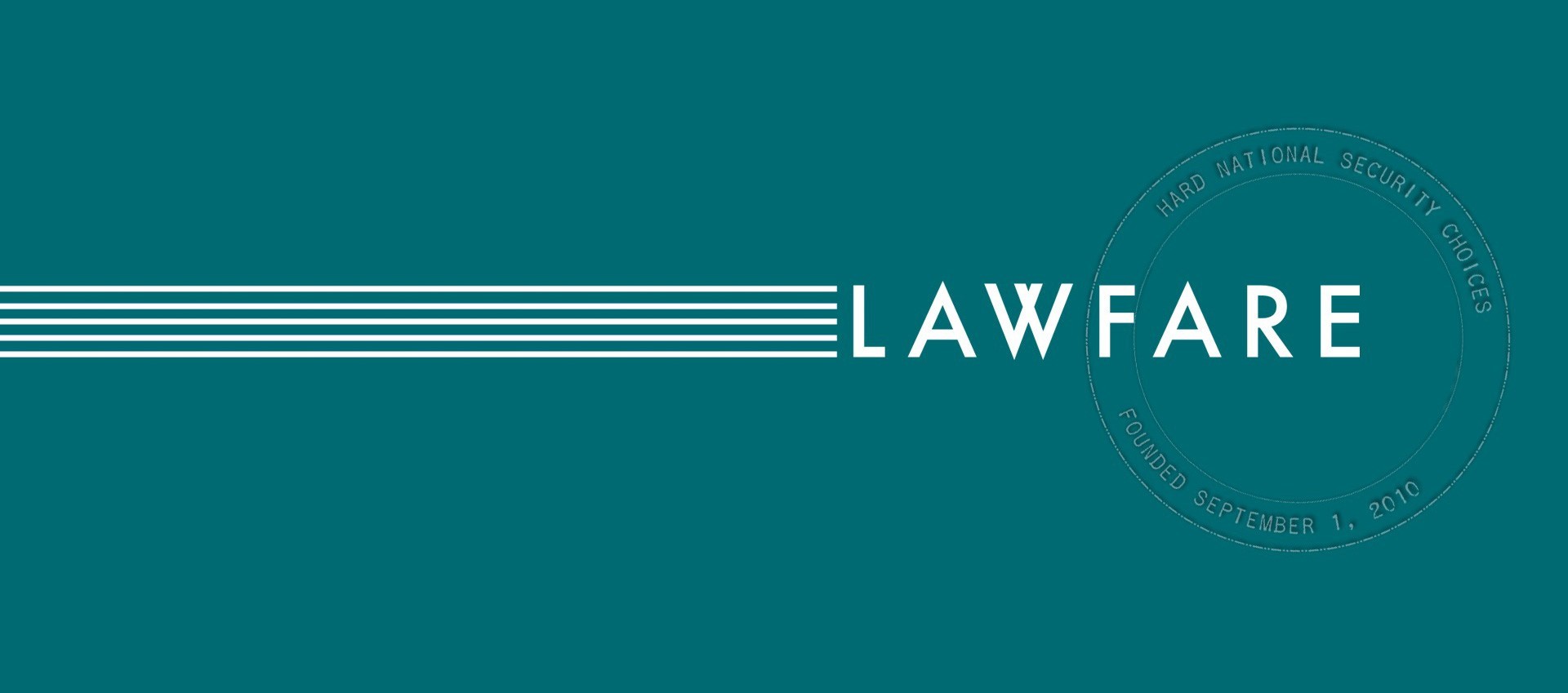Belarus’s Lawfare Against Latvia, Lithuania and Poland
Belarus is currently using migrant issues as “lawfare” in its hybrid operations against Western European neighbors.

Published by The Lawfare Institute
in Cooperation With

In recent months, Belarus has been sending foreign migrants to its western borders with Latvia, Lithuania and Poland. While this might appear to be a strategy to combat a rise in immigration, it’s actually Belarus’s latest effort in waging hybrid warfare against its neighbors. Hybrid warfare is an increasingly popular tool used by both state and non-state actors to achieve military and political objectives. NATO defines hybrid threats as the combination of military and nonmilitary means—specifically disinformation, cyberattacks and the deployment of irregular forces—to achieve an objective. As part of hybrid warfare, state and non-state actors are increasingly using “lawfare” as effective nonmilitary means.
Lawfare was popularized by Maj. Gen. Charles J. Dunlap, USAF (retired), who defined it as “a method of warfare where law is used as a means of realizing a military objective.” Dunlap points out that adversaries often use lawfare by leveraging Western democracies’ compliance with the rule of law as a means of achieving a military or political objective in a broader conflict. In democracies, if a war is seen as illegal or immoral, it will lose public support. Therefore, adversaries assault the moral and legal foundations of Western democracies’ actions. As Belarus has demonstrated, the same logic might apply to human rights issues.
Over the past few months, Belarus has sent migrants to neighboring countries with the apparent expectation that the migrants’ presence on the border would put pressure on Latvia, Lithuania and Poland to admit the large flow of migrants or violate human rights treaties enforceable against those countries. Belarus’s use of foreign migrants at its borders is an apparent example of lawfare.
This strategy appears to be a reaction to Western sanctions and diplomatic pressure. Tensions between Alexander Lukashenko’s autocratic regime and the European Union came to a head following Belarus’s election in 2020. Lukashenko claimed victory in what was widely seen as a fraudulent election, and the regime used heavy-handed and violent tactics to repress protests against the results. The EU rejected the results and imposed sanctions against the Lukashenko government. Opposition leaders, including Lukashenko’s challenger and journalists, fled the country in response to the violence.
On May 23, Ryanair flight FR4978 from Athens, Greece, was redirected from its destination in Vilnius, Lithuania, to Minsk, Belarus, due to an alleged bomb on board the flight. Upon landing, Belarusian opposition activist Roman Protasevich and his girlfriend were removed from the flight. European leaders believed that the bomb threat was a pretense to arrest Protasevich. The EU imposed additional sanctions on Belarus, and airlines began to reroute flights outside of Belarusian airspace. Belarus caused other rifts with its neighbors, including the expulsion of Latvian diplomats over a dispute regarding a red and white Belarusian opposition flag flying in Latvia and a separate incident when Belarusian border guards attempted to read Lithuanian diplomatic mail.
Officials from the EU, including the European commissioner for home affairs and various other European ministers, have stated that the sanctions and deteriorating diplomatic relations between Belarus and its neighbors were the catalyst behind Belarus’s decision to force large numbers of migrants to its borders. Specifically, the EU alleges that Belarus flew Iraqi and Afghani migrants to Belarus and then forced them to its borders in an effort to destabilize Latvia, Lithuania and Poland. It is estimated that 4,100 Iraqi migrants entered Lithuania in 2021 alone. Poland built fencing along the border and, to date, has sent almost 6,000 troops to reinforce border guards and prevent migrants from entering Poland.
As an example of hybrid warfare, Belarus’s deployment of migrants to the border has been successful. The presence of migrants has had destabilizing political effects and is aimed at the strategic goal of punishing its neighbors and the EU for sanctions imposed on Belarus. Such destabilization will only increase as temperatures drop in the coming winter months. Already, at least five migrants have reportedly died.
The lawfare component of this maneuver is likely to play out in the European Court of Human Rights (ECtHR). Belarus is the only European country that is not a party to the European Convention on Human Rights (ECHR) and may therefore act outside of European norms, while simultaneously using such norms against members. The manner in which Belarus forced migrants to its western border is an egregious violation of human rights and international law, but one for which the ECtHR cannot hold Belarus accountable. Migrants have complained to aid workers and journalists about the lack of food, shelter and medicine in Belarus. Yet, as Belarusian border guards force the migrants toward the western border, these migrants can only seek recourse from the ECtHR against the neighboring countries beholden to the court: Latvia, Lithuania and Poland.
On Aug. 20, migrants located on Belarus’s western border brought their complaints to the ECtHR. In the cases of R.A. and Others v. Poland and Ahmed and Others v. Latvia, migrants sought immediate relief under Rule 39 for “food, water, clothing, adequate medical care and, if possible, temporary shelter.” Both cases rely on the ECHR, including Articles 2 (right to life), 3 (prohibition of inhumane treatment), 4 (prohibition of collective expulsion of aliens), 5 (right to liberty and security), 6 (right to a fair trial), 8 (right to private family life), and 13 (right to an effective remedy). The court decided on Aug. 25 that Poland and Latvia had to provide “food, water, clothing, adequate medical care and if possible, temporary shelter.” Notably, the court did not compel Poland and Latvia to admit the migrants and recognized Poland’s and Latvia’s right to control entry and residence within their own countries. However, following those decisions, the ECtHR applied Rule 39 in the case of A.S. and Others v. Lithuania, stating that Lithuania temporarily could not send migrants back to Belarus after they crossed the Lithuanian border. The court has held, and will continue to hold, Latvia, Lithuania and Poland to their human rights law obligations.
If one of the goals of strategic lawfare is to erode public or international support for your adversary’s position, Belarus’s migrant operation has been effective. Because of their membership in the ECtHR, Latvia, Lithuania and Poland are held to a higher human rights standard than Belarus. The court forced Poland and Latvia to explain why they will not provide food, shelter and water for migrants whom they are actively keeping off their territories despite harsh conditions. The court also would not permit Lithuania to return migrants to Belarus once they reached Lithuanian territory. Human rights activists have called attention to the border regions, calling the refugee situation a tragedy and faulting their own governments for their response. Right-wing political parties, including Poland’s Law and Justice party, have used the migrant crisis as a rallying cry to secure borders. Meanwhile, Belarus has separately accused Lithuania of ignoring “all requests for asylum.” Belarus has successfully exploited Latvia’s, Lithuania’s and Poland’s legitimate concerns regarding mass migration into their territories. Now, they may be forced to violate the ECHR’s prohibition of refoulement. The Convention and Protocol on the Status of Refugees (Refugee Convention) calls refoulement the return or expulsion of “a refugee in any manner whatsoever to the frontiers of territories where his life or freedom would be threatened[.]”
Could returning migrants to Belarus constitute refoulement? Possibly. Belarus has largely been under authoritarian rule since the 1990s, and the regime has often used repressive means to control its population. Repressive tactics have escalated in recent years, including crackdowns on opposition students and activists. The U.N. High Commissioner on Human Rights (UNHCHR) office received reports of 450 cases alleging torture, mistreatment and illegal deprivation of liberty after the election of August 2020. In recent months, Belarus has not relented. In early August, Belarusian activist Vitaly Shishov died in Ukraine under suspicious circumstances, which Ukrainian police are investigating as a possible murder. Belarusian Olympian Kristina Timanovskaya defected from the Olympics and was offered asylum in Poland after she critiqued the Belarusian coaching and Olympic staff headed by Alexander Lukashenko’s son, Victor. Aside from these well-known examples, 650 people were detained in Belarus because of their beliefs, including 497 journalists and media workers, 68 of whom were allegedly mistreated, and the government shut down 129 civil society organizations.
Belarus is a party to the International Covenant on Civil and Political Rights and the U.N. Convention against Torture and is subject to the UNHCHR’s review. The UNHCHR found allegations credible that Belarus has violated its international obligations. Additionally, the EU, United Kingdom and the U.S. sanctioned Belarus for the election and the resulting crackdown on opposition.
Although the court did not force Poland and Latvia to receive or grant asylum to the migrants, Latvia, Lithuania and Poland have arguably taken a position that puts them at risk of committing refoulement by sending the migrants back to Belarus. Notably, the ECtHR’s recent decision with Lithuania seems to be almost a warning not to commit refoulement. International law prohibiting refoulement of refugees is relatively robust. Alongside the Refugee Convention’s explicit prohibition of refoulement, the U.N. Humans Rights Committee has interpreted Article 7 (prohibition of torture) of the International Covenant on Civil and Political Rights as an implicit prohibition of refoulement outside the Refugee Convention. Additionally, the ECtHR has found that the ECHR’s Article 3, prohibition against torture, implicitly prohibits refoulement. Latvia, Lithuania and Poland are aware that migrants returned to Belarus are at high risk of suffering torture, cruel and inhumane treatment, or other human rights violations, which could constitute refoulement.
The ECtHR could hold Poland and Latvia accountable for violating prohibitions on refoulement. The ECtHR extends the application of the prohibition of refoulement to people under the jurisdictions of nations, not only within a country’s territory. For instance, in the case of Hirsi Jamaa and Others v. Italy, the court determined that Italy committed refoulement by returning migrants rescued on the high seas to Libya, a country where migrants were at risk of serious human rights violations. The court found, specifically, that “[t]he prohibition of refoulement is not limited to the territory of a State, but also applies to extraterritorial State action.” In this case, “extraterritorial State action” referred to the high seas, but it could be applied to the situation in Latvia, Lithuania and Poland. Therefore, as with Italy in the Hirsi Jamaa case, Poland’s, Lithuania’s and Latvia’s decisions to knowingly force migrants to return to Belarus could be considered refoulement.
Besides the risk of refoulement, the mere fact that cases could be (and already have been) brought against Belarus’s neighboring countries satisfies Belarus’s strategic goals. As discussed, Belarus’s harsh treatment of migrants subjects neighboring governments to questions regarding their own adherence to human rights law, both internationally and locally. Lukashenko (much like Russia’s Vladimir Putin) often resorts to “whataboutisms” when responding to questions about his alleged human rights abuses. Lukashenko will use cases brought to the ECtHR to shift focus from his own abuses in Belarus to the migrant issues at the border.
The actions will have political, and perhaps economic, impacts, all pointing to an overall hybrid threat strategy. It is impossible to analyze Belarus’s hybrid strategy without recognizing the lawfare component. Although Belarus is not bringing legal action itself, actions taken against Latvia, Lithuania and Poland will help meet Belarus’s strategic and military goals through legal means.




